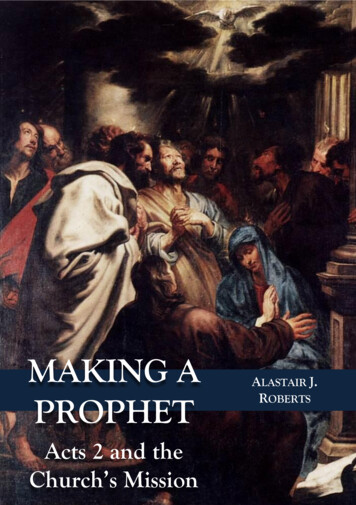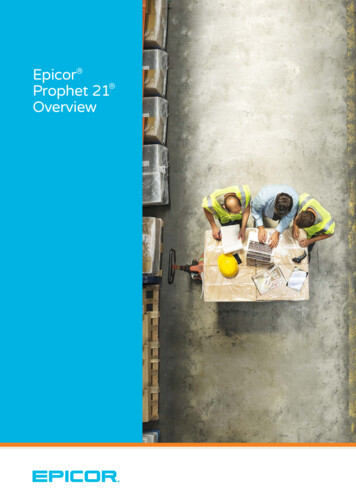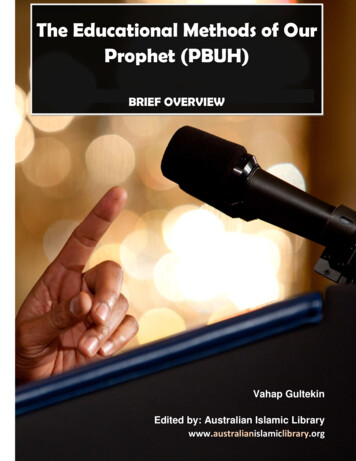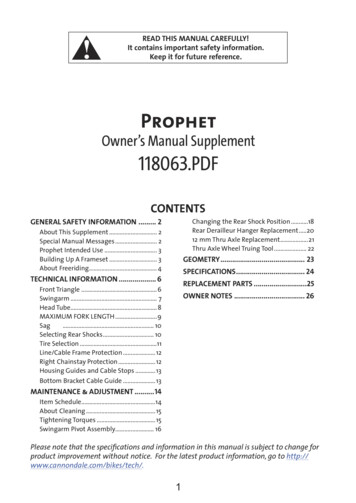
Transcription
MAKING APROPHETActs 2 and theChurch’s MissionALASTAIR J.ROBERTS
MAKING APROPHETActs 2 and theChurch’s MissionAlastair Roberts2016
1BACKGROUND TO PENTECOSTavlla. lh,myesqe du,namin evpelqo,ntoj tou/ a gi,ou pneu,matojevfV u ma/j kai. e;sesqe, mou ma,rturej e;n te VIerousalh.m kai.ÎevnÐ pa,sh th/ VIoudai,a kai. Samarei,a kai. e[wj evsca,touth/j gh/jÅActs 1:8The first chapter of the book of Acts presents us withboth an ending and a beginning. Bringing to a close theperiod of his earthly ministry, Jesus’ ascent into heavenalso marks the beginning of a new act in the drama of theNT, that of the public mission of the church.The exact nature of the relationship between theministry of Jesus and the ministry of his church will be amatter of continuing interest for us throughout the pagesthat follow. Within this booklet, I will attempt todemonstrate that the events of Pentecost set the churchapart as a prophetic community. Bringing the text of theopening chapters of the book of Acts into conversationwith particular texts within the OT, I hope to explore the3
manner in which accounts of prophetic call, anointingand succession can provide a helpful lens through whichto view the events of Pentecost. In making my case, I willbe devoting most of my attention to a closer analysis ofActs 2:1-4.This is not the first study to explore the theme ofprophetic anointing in Acts 2. In The Prophethood of AllBelievers, Roger Stronstad devotes a chapter to the event ofPentecost, which he claims inaugurates ‘the prophethoodof all believers.’1 The theme is also highlighted by somecommentators in the course of their treatment of thepassage, and in wider treatments of Luke-Acts.2 WithinEchoes of Scripture in Luke-Acts, Kenneth Litwak identifies anumber of the OT passages that the narrative of the earlychapters of Acts evokes, unearthing some neglectedallusions to prophetic call and succession narratives in theprocess.Building upon the foundation that these writers haveestablished, and entering into constructive conversationwith them, I hope to probe deeper into the OTbackground for the prophetic themes that surface inLuke’s account of Pentecost. Attempting an intertextualreading of Acts 2, I aim to prove the theological andexegetical value of understanding the account in terms ofOT accounts of prophetic call, anointing and succession.12Stronstad 1999, 70E.g. Wall 2002, 54-55; Keener 1997, 190ff; Johnson 1992, 12-14.4
Jesus and the Church in Luke-ActsFor Luke the ministry of the church is inseparablyconnected to Jesus’ own ministry, something highlightedby the resumptive character of his introduction to thebook of Acts.3 As Ben Witherington argues, Luke situateshis account of Jesus within a ‘wider historical framework’,giving considerable prominence to the events precedingthe birth of John the Baptist at the very outset of hisnarrative and closely following the subsequent growth ofthe church in the second volume of his work.4 Remarkingon the limited attention that Luke gives to Peter’sconfession in his gospel, in contrast to the accent placedon the accounts of the commissioning of the Twelve andthe Seventy between which it is sandwiched,Witherington writes:Nowhere is it made more apparent than in thissequence that Jesus is the initiator of a series of eventsand proclamations that his disciples undertake duringand then after his time. The focus is not just on Jesusbut on the historical Jesus movement of which he wasthe catalyst and focal point.5In adopting a narrow focus on the identity andpersonal ministry of Jesus we are in danger of failing toappreciate the degree to which the Lukan treatment ofthe early church is driven by more than a merely3Witherington 1998, 9ff; Wall 2002, 37-38Witherington 1998, 21-245Ibid, 23-2445
biographical or historical interest. For Luke the churchplays a key role in the drama of God’s salvation, both asthe place where that salvation is realized and as the agencythrough whom it is borne witness to and spread.Baptism, Ascension, and Elijah TypologyImmediately prior to his ascension, Jesus promises hisdisciples the gift of the Holy Spirit, a gift for which theymust wait in Jerusalem. Recalling the contrast drawn byJohn the Baptist in Luke 3:16, Jesus speaks of thereception of the Spirit in terms of the language ofbaptism. By describing the church’s forthcomingreception of the Holy Spirit in such a manner, Jesuspresents the event that is about to occur to the church assomehow analogous to the type of event that John’sbaptism represented. The baptism with wateradministered by John the Baptist will now be followed bya baptism with the Spirit that Jesus will perform on hisdisciples.Within Lukan theology, John’s baptism is presented asplaying a preparatory role (cf. Acts 19:1-6).6 It preparedthe people for the coming kingdom of God and alsoserved as the ‘launching-pad’ for Jesus’ own work.7 InLuke’s gospel we see that Jesus’ own baptism by John theBaptist marked the beginning of his public ministry (Luke3:20-22), a detail that is given significance in the firstchapter of Acts (Acts 1:21-22). In the narrative of Luke’sgospel, John’s baptism of Jesus also marks the end of67Ibid, 571Wright 1996, 2286
John’s place in the foreground of the gospel narrative.Once the ministry of Jesus has gotten off the ground, thepurpose of John’s ministry has more or less beenaccomplished.8Within the gospels John the Baptist is presented ‘as insome sense Elijah redivivus.’9 In an allusion to theprophecy of Malachi 4:5-6, the angel Gabriel declares toZecharias that his son John will go before the Lord evnpneu,mati kai. duna,mei VHli,ou (Luke 1:17). Elsewhere,Jesus declares that John was the Elijah that was promisedto come (Matthew 17:10-13). The description andnarrative of John the Baptist is also replete with allusionsto the description and narrative of the prophet Elijah.10Perhaps it is significant that John’s baptism of Jesustakes place on the far side of the Jordan: this was theplace where Elisha succeeded Elijah (2 Kings 2) andJoshua took over from Moses (Joshua 1). In all cases thesuccession involves a crossing or coming out of the river8A point made more explicitly in the fourth gospel (John 1:29-34;3:27-30).9Wright 1996, 16710John the Baptist is an ascetic and peripatetic prophet who, likeElijah, calls Israel to repentance in light of coming judgment. Hedresses like Elijah (Mark 1:6; cf. 2 Kings 1:8) and, like Elijah, isassociated with the wilderness. Like Elijah, his ministry is opposed bya tyrant with a manipulative wife (Herod & Herodias / Ahab &Jezebel). Significantly, John the Baptist’s ministry begins at thegeographical location where Elijah’s ministry ended (Matthew 3:1;Mark 1:4-5; cf. 2 Kings 2:4-11 [Dapaah 2005, 42]).7
and a reception of the Spirit (Deuteronomy 34:9; Joshua1:10-18; 2 Kings 2:9-15; Luke 3:21-22).11At Jesus’ baptism by John, the Spirit descends uponhim in the form of a dove (Luke 3:22), fills him and leadshim into the wilderness (Luke 4:1). Within Lukantheology, there is a very close connection between fillingwith the Spirit and prophecy (Luke 1:15, 41-45, 67; Acts2:4, 17-18; 4:8, 31; 7:55-56; 13:9-11).12 Jesus’characterization of himself as a prophet in Luke 4:24, inthe context of his reading of Isaiah 61:1-2 is significant. Itis the descent of the Spirit upon Jesus at his baptism thatsets him apart as a prophet.13 The connection betweenbaptism and investiture is an important one for ourpurposes:14 the church’s reception of the Spirit in the‘baptism’ of Pentecost needs to be understood as anordination for prophetic ministry.Luke does not limit his deployment of Elijah imageryto his treatment of John the Baptist. As N.T. Wrightobserves, there is strong evidence to suggest that thesynoptics also understand the work of Jesus in terms ofElijah typology.15 It is at the point of Jesus’ ascension thatthis imagery assumes a greater prominence. Commenting11We will explain some of the parallels between these passages moreclosely at a later point of this study.12Dunn 1998, 11-1213Acts 10:38. Richard Hays argues that Luke presents Jesus as a‘prophetic liberator’ [Hays 1996, 117].14Although its focus is on the connection between baptism andpriestly ordination, much of Leithart 2003, 87ff is relevant to ourcase.15Wright 1996, 1678
on the ascension account in Luke 24:50-53, KennethLitwak writes:If Luke’s audience encountered a story of someoneapproved by God ‘going up’ to heaven, they wouldsurely have thought of Elijah’s ascension since his isthe only ascension account in the Scriptures of Israel.The statement in Lk. 24.49 that the disciples would beempowered by the Spirit recalls Elijah’s bequest of his‘spirit’ to Elisha (4 Kgdms 2.9-10). The use ofevndu,shsqe in Lk. 24.49 may also be an allusion toElijah’s mantle which was passed on to Elisha (2Kgdms 2.13) 16The OT speaks of the future return of the ascendedElijah to restore all things (Malachi 4:5-6; cf. Sirach48:10), a theme that also appears in the NT (Mark 9:12;Matthew 17:11). Significantly, Luke ascribes to theascended Jesus that which was traditionally ascribed toElijah: in Acts 3:21 he speaks of Jesus as the one o]n dei/ouvrano.n me.n de,xasqai a;cri cro,nwn avpokatasta,sewj (cf.Acts 1:11).17Giving the dominance of such Elijah imagery in thecontext of the ascension, Jesus’ promise of the Spiritimmediately prior to his rapture must take on an addedsignificance. The Elijah imagery provides the typologicaladhesive binding together ascension, Pentecost and1617Litwak 2005, 147Zwiep 1997, 114-1169
parousia.18 Within the frame provided by the Elijahtypology, an intimate connection is seen to exist betweenthe ascension and Pentecost narratives. Consequently,any attempt to understand the events of Pentecost mustbegin by giving attention to the Lukan ascensionaccounts.The Ascension and the Prophetic Anointing of theChurchJust as Jesus’ baptism by John marked the beginning of hisprophetic ministry and his succession from John’s ownministry, so the ascension and Pentecost mark the timewhen the church is anointed for its prophetic ministryand the transition from Jesus’ public earthly ministry tothat of the church.The two most important prophetic successionnarratives of the OT involve the transition from theleadership of Moses to the leadership of Joshua (Numbers27:12-23) and the transition from the prophetic ministryof Elijah to that of Elisha (2 Kings 2:1-15).19 In both ofthese cases the mission started by the first prophet iscompleted by his successor.20 Moses’ mission to lead thechildren of Israel out of Egypt and into the PromisedLand is only fulfilled in the ministry of his successor18Ibid, 194Leithart 2000b, 170-171, and Durham & Porter 1970, 119-121n62observe some of the parallels between Moses and Joshua and Elijahand Elisha.20Joshua’s succession from Moses is presented as a propheticsuccession in Sirach 46:1.1910
Joshua. Similarly, the mission that Elijah is charged within 1 Kings 19:15-17 is only completed in the ministry ofElisha (2 Kings 8:13; 9:1-3).21Elisha is a new Elijah (2 Kings 2:15), just as Joshua is anew Moses (Numbers 27:20; Joshua 1:5).22 The parallelbetween the ministries of Joshua and Elisha and theministry of Jesus’ disciples is worth highlighting. BothJoshua and Elisha serve as apprentices to prophets, whoseministries they inherit following the time of their masters’departures. The same pattern holds in the case of Jesus’disciples: having left their work to follow Jesus asdisciples, they receive their master’s Spirit following hisdeparture and continue his mission.23The relationship between the prophet and hisapprentice is akin to the relationship between a fatherand his son. In Numbers 13:16 we see that Joshua’s namewas given to him by Moses. Moses also lays his hands onJoshua (Deuteronomy 34:9) in a manner reminiscent ofthe patriarchs’ blessings on their sons (Genesis 48:13-20).A similar relationship exists between Elijah and Elisha.Elisha receives a ‘double portion’ ( yIn:v.-yPi) of Elijah’s spirit,the inheritance appropriate to the firstborn(Deuteronomy 21:17),24 and, as Elijah is taken intoheaven, Elisha addresses him as his ‘father’. Jesus’ farewelldiscourse and blessing of his disciples (Luke 24:51)belongs within this pattern of prophetic succession.21Leithart 2006, 213Leithart 2000b, 10823Leithart 2006, 17124Elisha is thus given the pre-eminent position among the ‘sons ofthe prophets’ (Ibid, 173; Moberly 2006, 134-135).2211
Zwiep notes the parallel between the stress on thevisibility of the master’s departure in both the account ofElijah’s rapture and that of Jesus’ ascension.25 SeeingElijah taken up was an indispensable condition forElisha’s right to succeed him. Moberly explains the logicof the test: ‘ it is the responsibility of the prophet to beable to see God, and if Elisha cannot see God in thiscritical instance, then he is not able to take on the role ofone who sees God in other instances; Elisha cannot be aprophet like Elijah unless he has the requisite spiritualcapacity.’26 The Lukan stress on the disciples’ witnessingof Jesus’ ascension might serve to underline theirsuitability for prophetic office.27Elijah and Moses typology is multilayered within theLukan literature. However, in the critical movement inthe narrative with which we are concerned, the disciplesare typologically related to Joshua and Elisha. As their25Zwiep 1997, 116, 194. Observe the repeated use of verbs of visualperception in Acts 1:9-11.26Moberly 2006, 13527Johnson 1992, 31. The encounters with the risen Christ asrecorded by the gospels might also be worth considering in thiscontext. Delayed recognition of—or failure to recognize—the risenChrist is a recurring feature in the post-resurrection narratives(Matthew 28:17; Luke 24:13-35; John 20:14-18; 21:12; cf. Mark16:12). The liturgical structure followed by the Emmaus road accountof Luke 24:13-35 (Wright 2003, 659-660), accompanied by thedisciples’ initial failure to recognize their companion on the road,might suggest that, although firmly embodied and visible as such, theidentity of the body of the risen Christ is something that can eludemundane perception (although see the discussion of this in Davis2006, 129ff) and is only truly accessible to those granted spiritualvision (Balthasar 2000, 218-219).12
master departs, they will inherit his Spirit and continuehis mission. The Spirit that the disciples will receive is theSpirit of Christ, the Spirit that supervised and empoweredhis own mission.2828Congar 1983, 45.13
2ACTS 2:1Kai. evn tw/ sumplhrou/sqai th.n h me,ran th/j penthkosth/jh san pa,ntej o mou/ evpi. to. auvto,ÅIn setting the scene for the events of Pentecost, Lukeimmediately draws our attention to the fact that all of thedisciples are assembled together in one place (h san pa,ntejo mou/ evpi. to. auvto,). Remarking on the ‘togetherness’ ofthe disciples, Richard Thompson observes:Although Luke does not explicitly state why thiscorporate quality is important or how these believersconcretely demonstrate such a quality, such anemphasis suggests that this characteristic is criticalboth to the narrative and potentially to what follows.29What are we to make of the corporate character of theevents of Pentecost?29Thompson 2006, 3814
A Community of ProphetsPentecost (re)constitutes the community of the earlychurch in a powerful way, representing an event ofdecisive importance for its formation and identity. Forthis reason it is perhaps significant that we find a numberof possible echoes of the events of Sinai in the immediatecontext. Sinai was an event of immense importance forIsrael in its life as a nation, being the occasion of a grouptheophany, their reception of the Torah and theirentrance into a covenant with YHWH. Kenneth Litwakwrites:There are several striking elements which suggest thatLuke shaped his account on the basis of the Sinaitradition. Acts 2 opens with a theophany, whichincludes fire and a loud sound (Acts 2.1-4; cf. Exod.19:16 [sound of a trumpet] and Exod. 19.18 [YHWHdescended upon Sinai in fire]). At Sinai God spoke toMoses, and in Acts 2.11 the people hear the disciplesspeaking of the mighty works of God. On a broaderlevel, the theophanic event in Acts 2.1-4 is formativefor the first followers of the Way, just as the Sinaitheophany was formative for God’s people inExodus.3030Litwak 2005, 165-166. Stronstad 1999, 58-59 highlights a numberof further common features of the Sinai and Pentecost narratives,including the days of preparation and the occurrence of thetheophany in the morning.15
In Exodus 19:1 we read that the children of Israelarrived at Sinai three months after leaving Egypt, where,after a few days of preparation, they received the Law. Asthe feast of Pentecost occurred 49 days after the Feast ofFirstfruits (Leviticus 23:15-16), which took place in thelatter half of the first month, the possibility of achronological connection between Pentecost and thegiving of the Law and forming of the covenant in Sinai israised.31 This connection did not go unnoticed by therabbis, who identified Pentecost as the feast celebratingthe gift of the Law.32 Whether such a connection wasestablished by the time that Luke wrote the account ofActs 2 is uncertain and continues to be a matter of debateamong scholars.33Taken by itself this connection between Pentecost andSinai may appear rather slight, but it is given more weightwhen we consider it alongside the presence of the otherechoes of the Sinai account in the early chapters of Acts.3431A number of writers reference Jubilees 6:17-21 in this context (e.g.Hovenden 2002, 78; Bruce 1965, 54n5). Hovenden observes theconnection that Jubilees draws between Pentecost and covenantrenewal (see also Charlesworth 1985, 2:67nf).32E.g. Witherington 1998, 130-131; Johnson 1992, 45-46; Wall2002, 54; Hovenden 2002, 77ff; Marshall 1980, 68; Berends 1998.33Keener 1997, 193 counsels against placing too much weight on thepossibility of a connection between the two events in the mind ofLuke, as does Dunn 1975, 139-141. Wall 2002, 54 and Johnson1992, 46 both raise the possibility that the connection between thetwo events may have been one made by Luke himself.34Besides those already mentioned, there are a number of furtherechoes of Sinai narrative in Acts 2. The ascension of Christ into thecloud (Acts 1:9) might be an echo of the ascension of Moses onto16
At Sinai Israel was set apart as a ‘kingdom of priests and aholy nation’, giving the children of Israel a special role toplay within God’s purposes for the wider creation. Theparallels to the event of Sinai are important chiefly onaccount of the way in which they frame the event as onethrough which the disciples are set apart as a people witha new vocation.In contrast to the examples of prophetic successionthat we previously observed, the example of Sinai involvesthe reconstitution and setting apart of a whole people andnot just of one person. The events of Pentecost are not ofmere private significance to those involved, but herald theestablishing of a new reality in the realm of history. Sinaiinaugurates a new era and not merely a period ofleadership limited by one man’s lifespan. Consequently,the event of Sinai has much light to shed on Luke’saccount of Pentecost. Stronstad writes: [W]hat is happening on the day of Pentecost is notonly as dramatic as, but also as significant as whatMount Sinai. The number added to the church (katenu,ghsan th.nkardi,an) in Acts 2:41 may also echo the number slain by the sword atSinai (Exodus 32:28). Wedderburn 1995 argues for a connectionbetween the events of Sinai and those of the Day of Pentecost as theyare recorded in Acts, but claims that this connection was not made byLuke, but by some of his sources. Hovenden 2002, 77ff has a veryhelpful discussion of some further possible literary connections,including that of a Lukan allusion to Psalm 67:19 (LXX) in Acts 2:33(see also Litwak 2005, 166), a verse applied to Moses at Mount Sinaiby some of the rabbis. Johnson 1992, 46 highlights the similaritiesbetween the statement concerning Moses in Stephen’s speech in Acts7:38 and that of Peter concerning Jesus in Acts 2:33.17
happened at Mt Sinai. In other words, the creation ofthe disciples as a community of prophets is as epochalas the earlier creation of Israel as a kingdom ofpriests.35The Distribution of the Spirit of JesusA number of commentators have argued for some form ofconnection between the narrative of Numbers 11 andthat of Acts 2, a connection that can illuminate certaindimensions of the church’s prophetic character.36In Numbers 11 Moses appeals to YHWH to ease theburden of leadership that he is bearing. Responding to hisplea, God instructs Moses to gather seventy of the eldersof Israel and bring them to the tabernacle of meeting.There God will take of the Spirit that is on Moses andgive it to the elders, so that they can share the task ofleading the people with him.Following a day of preparation, the elders are gatheredtogether and the Spirit rests on them. They then begin toprophesy, although they never do so again (Numbers11:25).37 Two of the seventy elders—Eldad and Medad—were not present at the tabernacle of meeting at the time,but received the Holy Spirit nonetheless and began toprophesy in the middle of the camp. Joshua, Moses’35Stronstad 1999, 59E.g. Cotton 2001; Williams 2003; Litwak 2005, 165; Estrada 2004,210ff37The meaning of the phrase Wps'(y" al{ïw is not entirely clear (Ashley1993, 214; Williams 2003, 127-128). In light of the similar phraseused in Deuteronomy 5:22, we have opted to understand it as adenial of their continuance in prophesying.3618
assistant, concerned by this, asks Moses to instruct themto stop. Moses, however, was unconcerned: ‘Are youjealous for my sake? Oh, that all the Lord’s people wereprophets and that the Lord would put His Spirit uponthem!’ (verse 29).There are a number of echoes of the theophany atSinai in the account of Numbers 11, including: (1) thegranting of a new vocation to a body of people (Exodus19:5-6; Numbers 11:16-17); (2) the command for thepeople to sanctify themselves for the coming day whenYHWH will act decisively (verse 18: rx'm'l. WvåD q;t.hi; cf.Exodus 19:10: rx"m'W AYh; T'v.D:qiw ['h'-la, %lE);38 (3) thegathering of the people around a particular location, MtSinai in the Exodus account and the tabernacle in that ofNumbers (Numbers 11:24);39 (4) a theophany in whichGod comes down in the cloud and speaks with Moses(Exodus 19:9; Numbers 11:25).Although some might argue that the ‘spirit’ given tothe seventy elders is Moses own spirit, rather thanYHWH’s, a reading of Numbers 11 that understands the‘spirit’ as YHWH’s own Spirit seems far more satisfactory(cf. verse 29). Nevertheless, it is important that werecognize that the Spirit that is given to the seventy eldersis spoken of as the Spirit that is upon Moses himself(Numbers 11:17, 25). Although we are not here dealingwith a ‘sacramental transfer’ in which Moses is active,4038Ashley 1993, 212The possibility of the disciples being gathered around the templeon the Day of Pentecost will be discussed in the next chapter.40Williams 2003, 1313919
Moses is seen as the one who mediates the elders’reception of the Spirit. The elders do not receive theSpirit as a direct bestowal from God, but with ‘Moses asthe intermediary’.41Williams contrasts this with the case of leadershipsuccession that occurs when Joshua receives authority tolead and the ‘spirit of wisdom’ through the imposition ofMoses’ hands (Deuteronomy 34:9).42 In Numbers 11Moses does not abandon certain aspects of his leadershipto others. The elders are rather empowered to help fulfilMoses’ task of leading the people. Their ministry does notdisplace that of Moses, but involves a partaking in Moses’ministry.43At Pentecost Jesus mediates the gift of the Spirit to thechurch (Acts 2:33), and, much as the elders’ reception ofthe Spirit in Numbers 11 gave them a share in the Spiritof prophetic leadership that belonged to Moses, soPentecost brings the church to participate in theprophetic authority of Jesus, an authority that neverceases to be the exclusive possession of Jesus himself.At this juncture a further dimension of the ‘baptism’imagery (cf. Acts 1:5) may come to the fore: baptism doesnot merely initiate into office, it can also fulfil anincorporative purpose, bringing people to participate inthe life, authority, status or privileges of another (Romans6:3-5; 1 Corinthians 10:1-2; Galatians 3:26-29). Just asIsrael was led by Moses prior to being ‘baptized’ into a41Ibid, 130Ibid, 13143Ibid, 1324220
greater union with him,44 so the disciples were led byJesus prior to the baptism of Pentecost. What Pentecosteffected was the disciples’ reconstitution as the church—the body of Christ—bringing them into a new relationshipwith their master. They now shared in the power of hisSpirit, being bound to him by a bond of relationship farstronger than any they had previously enjoyed.45The temporary and unrepeated character of the elders’act of prophesying merits closer examination. While wehave good reason to believe that the Spirit remained withthe elders, enabling them to fulfil their role, the fact thatthey did not prophesy again suggests that prophesying wasnot necessary for this. The initial ecstatic manifestationswere not normative for the ongoing performance of theirduties. A similar occurrence can be found in 1 Samuel10:10-13, where the Spirit comes upon Saul, causing himto prophesy. It is through this experience that Saul is setapart and personally prepared for leadership (1 Samuel10:6). Apart from one other exceptional occasion,46 wenever read of Saul prophesying again. The prophecy wasan effect and an authenticating sign of the Spirit’s comingupon him; the continuance of the Spirit with him did stations.44As we shall later see, one dimension of this ‘baptism into Moses’was Israel’s entry into Moses’ own experience.45The incorporative purpose of the baptism of the Spirit is exploredin such places as 1 Corinthians 12:12-13.461 Samuel 19:21-24. This incident occurs after the Spirit hasdeparted from Saul (1 Samuel 16:14).21
There is a strong analogy to be observed between theprophesying of the elders and the glossolalia of thedisciples.47 As Dunn observes, Luke does not share Paul’ssharp distinction between speaking in tongues andprophesying.48 In his use of the passage from Joel in hissermon, Peter appears to equate the tongues-speaking ofthe disciples with the prophetic speech which theprophecy promises.49 In light of this OT background, itseems that the purpose of the glossolalia in the context ofActs 2 was primarily that of serving as an authenticatingsign of the Spirit’s coming upon the disciples. There is noreason for us to believe that glossolalia would continue tobe practiced by all of the disciples present at Pentecost.The passage from the prophet Joel that Peter uses inhis sermon is ‘strikingly parallel’ to the wish of Moses thatall of the people were prophets (Acts 2:17-18; Numbers11:29).50 This connection between the prophecy of Joeland Numbers 11 is also found is rabbinic midrash texts.51If, as Litwak maintains, the Joel prophecy provides a‘programmatic text’ and lens for Luke’s understanding ofPentecost,52 it is also a lens through which passages suchas Numbers 11 illuminate the text. The ‘prophethood of47Estrada 2004, 216-217; Cotton 2001, 7-8. Wenham 1981, 109suggests that we equate the two.48Dunn 1975, 228. Isaacs 1976, 90-91, argues that Paul is far morewary of ecstatic phenomena than Luke is.49Hovenden 2002, 8450Litwak 2005, 166. Barton 2001, 95 relates Joel 2 and Numbers 11together, claiming that Joel’s prophecy ‘reads almost as a fulfilment ofMoses’ hope expressed in Num. 11:29.’51Treier 1997, 18-1952Litwak 2005, 16222
all believers’ that is desired in Numbers, is prophesied inJoel and receives a form of fulfilment in Acts.53Perhaps we can even hear echoes of Eldad and Medadwhen we read of the Gentiles who received the Spirit inActs 10. Eldad and Medad were outside of the group ofelders at the tabernacle. Nonetheless, they still receive theanointing of the Spirit just as the others. In a similarmanner, the Gentiles may have appeared to be outside ofthe gathering to which the Spirit was specially promised,but they received the Spirit in much the same way, in asort of aftershock of the original event.54 By givingCornelius and his household the Spirit before they hadbecome members of a Jewish church, God demonstratedthe freedom of the Spirit and the fact that Jews andGentiles were accepted on an equal footing.53Stronstad 1999, 84On the question of whether there was one ‘Pentecost’ or many, seeDunn 1975, 136-138.5423
3ACTS 2:2kai. evge,neto a;fnw evk tou/ ouvranou/ h coj w[sperferome,nhj pnoh/j biai,aj kai. evplh,rwsen o[lon to.n oi konou- h san kaqh,menoiThe context having been set in the previous verse, theevents associated with the first Christian Pentecost beginin Acts 2:2. Given the significance of the event which heis recording, Luke is surprisingly economical in hisaccount of the Day of Pentecost.55 However, the fewdetails that he does provide grant the narrative more thanmerely a measure of colour and realism. The pyrotechnicsof verses 2-4 should alert us to the character of the eventthat is taking place. Roger Stronstrad observes:In the light of Israel’s history the meaning of the firsttwo signs, the metaphorical wind and fire would beself-evident signposts, both to the disciples and to theassembled crowd, that a theophany was happening.565556Johnson 1992, 45 refers to it as ‘slender and spare’.Stronstad 1999, 5524
Theophany and Prophetic CallJeffrey Niehaus defines a theophany as ‘an actualmanifestation of God’s presence’.57 Theophanies can takemany forms and are found in a variety of different biblicalcontexts.58 Theophanies generally occur a
characterization of himself as a prophet in Luke 4:24, in the context of his reading of Isaiah 61:1-2 is significant. It is the descent of the Spirit upon Jesus at his baptism that sets him apart as a prophet.13 The connection between baptism and investiture is an important one for our










